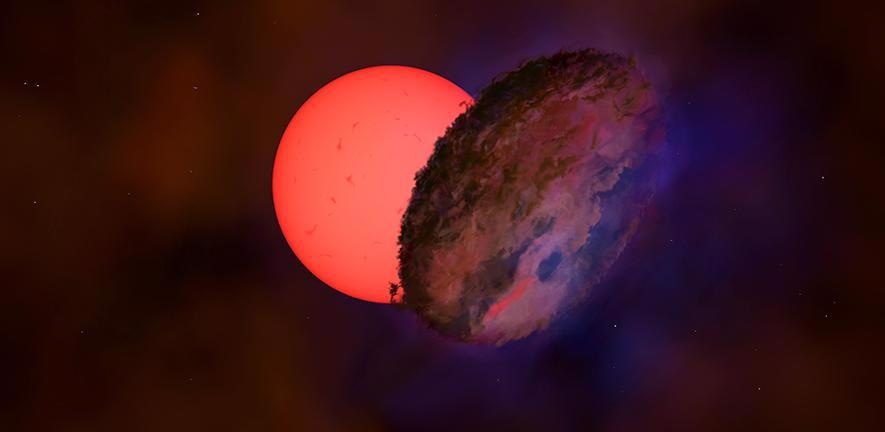Jun 14 2021
A global team of astronomers has found that a star, called VVV-WIT-08, was decreasing in brightness by a factor of 30 so that it almost vanished from the sky.
 Artist’s impression of the binary star VVV-WIT-08. Image Credit: Amanda Smith.
Artist’s impression of the binary star VVV-WIT-08. Image Credit: Amanda Smith.
Although several stars change in brightness because they either pulsate or are eclipsed by another star existing in the binary system, it is unusually rare for a star to become vaguer over a period of many months and then brighten up again.
According to the researchers, the VVV-WIT-08 star probably belongs to a new group of “blinking giant” binary star system, wherein a massive star — 100 times bigger than the Sun — is eclipsed once in every few decades by the yet-to-be-identified orbital companion. The companion, which is likely to be another planet or a star, is surrounded by an opaque disc, which encloses the giant star, causing it to vanish and appear again in the sky.
The new study has been published in the journal, Monthly Notices of the Royal Astronomical Society.
This latest finding was guided by Dr Leigh Smith from the Institute of Astronomy of the University of Cambridge, in association with researchers from the University of Edinburgh, the University of Hertfordshire, the University of Warsaw in Poland and Universidad Andres Bello located in Chile.
It’s amazing that we just observed a dark, large and elongated object pass between us and the distant star and we can only speculate what its origin is.
Dr Sergey Koposov, Study Co-Author, University of Edinburgh
Since the star is situated in a dense area of the Milky Way galaxy, the team speculated whether a few unidentified dark objects could have merely drifted in front of the massive star by accident. Yet, simulations have revealed that there would have to be an incredibly huge number of dark bodies moving around the Galaxy for this scenario to be possible.
Only one other star system of this kind has been known historically. The massive star, called Epsilon Aurigae, has been partially eclipsed by an enormous disc of dust once every 27 years, but only dims by around 50%. Another example, TYC 2505-672-1, was also detected a few years ago and holds the present record for the eclipsing binary star system with the longest orbital period of 69 years — a record for which the VVV-WIT-08 star is presently a contender.
In addition to the VVV-WIT-08 star, the UK-based researchers have also detected two more of these unusual giant stars, indicating that these may be a new group of “blinking giant” stars for astronomers to investigate.
The VVV-WIT-08 star was identified by the VISTA Variables in the Via Lactea survey (VVV), a project that uses the British-built VISTA telescope in Chile and managed by the European Southern Observatory that has been visualizing the same one billion stars for almost 10 years to look for examples with differing brightness in the infrared portion of the spectrum.
Occasionally we find variable stars that don’t fit into any established category, which we call ‘what-is-this?’, or ‘WIT’ objects. We really don’t know how these blinking giants came to be. It’s exciting to see such discoveries from VVV after so many years planning and gathering the data.
Philip Lucas, Professor and Project Co-Leader, University of Hertfordshire
While the VVV-WIT-08 star was identified with the help of VVV data, the dimming of the star was also visualized by the Optical Gravitational Lensing Experiment (OGLE) — a long-running observation campaign operated by the University of Warsaw.
The OGLE frequently makes observations, but proximal to the visible portion of the spectrum. Such frequent observations were crucial for modeling VVV-WIT-08 and the team demonstrated that the massive star dimmed by the same amount in both the infrared and visible light.
At present, there seem to be about half a dozen potential known star systems of this kind, comprising large opaque discs and giant stars.
There are certainly more to be found, but the challenge now is in figuring out what the hidden companions are, and how they came to be surrounded by discs, despite orbiting so far from the giant star. In doing so, we might learn something new about how these kinds of systems evolve.
Dr Leigh Smith, Institute of Astronomy, University of Cambridge
Journal Reference:
Smith, L. C., et al. (2021) VVV-WIT-08: the giant star that blinked. Monthly Notices of the Royal Astronomical Society. doi.org/10.1093/mnras/stab1211.